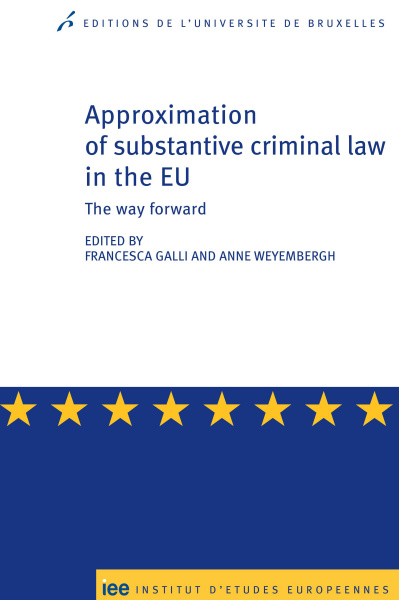Approximation of substantive criminal law in the EU
The way forward
Première édition
This book dedicated to the substantive criminal law in the EU put the Libson Treaty under scrutiny. It evaluates the changes introduced by this new Treaty and their impact, before reflecting on future prospects. Lire la suite
The European Union’s efforts to approximate substantive criminal law began under the third pillar of the Maastricht Treaty, then amended by the Amsterdam and Nice Treaties. As with other areas of cooperation in criminal matters, this domain has been ‘communitarised’ by the Lisbon Treaty. Since then, it is the area where the most initiatives have been introduced.
In this context, the purpose of the book is twofold. The first aim is to evaluate the changes introduced by the new Treaty and, three years after its entry into force, to provide an overview of the concrete implementation and practical impact of these changes. The second is to reflect on future prospects.
Following an introduction, which identifies the institutional and decision-making changes resulting from the Lisbon Treaty and examines the novel interactions among European actors, the book is divided into two main sections.
The first one develops a crosscutting approach, which can be applied to the approximation of substantive criminal law irrespective of any specific domain of analysis. It draws together reflections on the importance of fundamental principles of criminal law; on the so-called annex-competence provided for by Article 83(2) TFEU; on the role of the approximation of substantive criminal law with a view to the establishment of a European Public Prosecutor’s Office; and on the development of a general substantive criminal law for the EU.
The focus of the second part of the book is on evaluating the impact of EU approximation instruments in three selected areas (drug trafficking, terrorist offences and trafficking in human beings). In cases where successive EU instruments have been adopted over time, this second part will assess whether and to what extent evaluation processes had an impact on the drafting of subsequent provisions.
The edited volume ends with concluding remarks on the way forward.
This book has been co-written by an international team mainly composed of academics and researchers who are members of ECLAN (the European Criminal Law Academic Network).
Spécifications
- Éditeur
- Éditions de l'Université de Bruxelles
- Édité par
- Francesca Galli, Anne Weyembergh,
- Introduction de
- Anne Weyembergh, Serge de Biolley,
- Contributions de
- Jeroen Blomsma, Pedro Caeiro, Cornelis De Jong, Francesca Galli, Maria Kaiafa-Gbandi, Robert Kert, Andrea Lehner, Miguel Ângelo Lemos, Katalin Ligeti, Christina Peristeridou, Gisèle Vernimmen-Van Tiggelen, John A. E. Vervaele, Anne Weyembergh,
- Collection
- Études européennes | n° 53
- ISSN
- 13780352
- Langue
- anglais
- Site web ressource
- Oapen.org
- Catégorie (éditeur)
- > Droit
- BISAC Subject Heading
- LAW026000 LAW / Criminal Law
- Code publique Onix
- 06 Professionnel et académique
- CLIL (Version 2013-2019 )
- 3259 DROIT
- Subject Scheme Identifier Code
- Classification thématique Thema: Droit pénal : procédures et infractions
Livre broché
- Date de publication
- 09 octobre 2006
- ISBN-13
- 978-2-8004-1384-6
- Ampleur
- Nombre de pages de contenu principal : 144
- Code interne
- 1384
- Format
- 160 x 240 x 11 cm
- Poids
- 266 grammes
- ONIX XML
- Version 2.1, Version 3
Google Livres Aperçu
Sommaire
- Introduction
- CHAPITRE I – Les mécanismes du financement des universités
1. L'enseignement universitaire et son financement : vers l’uniformité
A. Les missions des universités
B. Aperçu historique
C. L’enseignement supérieur bipolaire, une caractéristique belge
2. Le financement de la recherche universitaire : vers la diversité
A. Le Fonds national de la recherche scientifique (FNRS)
B. Le mécénat
C. La collaboration avec les entreprises
D. Les pouvoirs publics, commanditaires de recherche
E. Les projets internationaux
F. Les Régions et la valorisation de la recherche
G. Une grande diversité
3. L’impossible synthèse
- CHAPITRE II – Le financement de la mission d’enseignement des universités francophones
1. Données recueillies
2. Analyse des chiffres relatifs aux « allocations de base »
3. Financement des étudiants en provenance des pays en voie de développement (PVD)
- CHAPITRE III – Les missions de recherche et de service des universités : la contractualisation
1. La contractualisation de l’aide au développement
2. La contractualisation des moyens de la recherche fondamentale
3. La contractualisation de la recherche publique à finalité économique
- CHAPITRE IV – Vers une vision d’ensemble de la recherche universitaire
1. Les dépenses de R-D des universités francophones
2. Structure des dépenses de R-D des universités francophones
3. Recherche fondamentale et recherche appliquée
4. Une évolution à long terme : la recherche à l’Université libre de Bruxelles (ULB)
A. Une tendance lourde
B. L’argent ne fait pas le bonheur
C. Un premier diagnostic
- CHAPITRE V – Les personnels des universités francophones
1. Brève typologie du personnel des universités
2. Le personnel « statutaire »
3. Le personnel « hors cadre »
4. Quelques conclusions
5. Une analyse plus fine
- CHAPITRE V – Quinze ans de fédéralisme
1. Fédéralisme, universités et recherche
2. Le financement de base des universités flamandes
3. L’effort de recherche de la Communauté flamande
4. Crédits destinés à la recherche industrielle
5. Des politiques différentes
6. Comparaison en moyens constants
A. En fonction du produit national
B. En fonction des produits attribuables à chaque Communauté
C. En fonction des produits régionaux
7. Comparaison en termes des dépenses des entités fédérées
8. Conclusion
- CHAPITRE VII – Le mirage américain
1. Le prix de l’éducation
2. Une recherche choyée ?
- CHAPITRE VIII – Quels moyens pour quelles universités ?
1. Une recherche trop orientée
2. Des formations sous-financées
3. Une compétition sournoise
- Conclusion
- Appendice. Le système institutionnel belge
1. Langues et communautés
2. Economie et régions
3. Un fédéralisme asymétrique
4. Quelques chiffres
- Annexes. Tableaux chiffrés
- Liste des abréviations, acronymes et sigles
- Liste des graphiques
- Liste des tableaux

